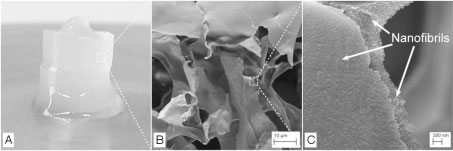| Aug 23, 2012 |
NanoHeal: Bio-compatible cellulose nanostructures for advanced wound healing applications
|
|
(Nanowerk News) Wound healing is a complicated process consisting of several different phases and a delicate interaction between different kinds of cells, signal factors and connective tissue substance. If the wound healing does not function optimally, this can result in chronic wounds, cicatrisation or contractures. By having an optimal wound dressing such negative effects can be reduced. A modern wound dressing should be able to provide a barrier against infection, control fluid loss, reduce the pain during the treatment, create and maintain a moist environment in the wound, enable introduction of medicines into the wound, be able to absorb exudates during the inflammatory phase, have high mechanical strength, elasticity and conformability and allow for easy and painless release from the wound after use.
|
|
Nanocellulose is a highly fibrillated material, composed of nanofibrils with diameters in the nanometer scale (< 100 nm), with high aspect ratio and high specific surface area ("Cellulose fibres, nanofibrils and microfibrils: The morphological sequence of MFC components from a plant physiology and fibre technology point of view"). Cellulose nanofibrils have many advantageous properties, such as high strength and ability to self-assembly.
|
|
Recently, the suitability of cellulose nanofibrils from wood for forming elastic cryo-gels has been demonstrated by scientists from Paper and Fibre Research Institute (PFI) and Lund University ("Cross-linking cellulose nanofibrils for potential elastic cryo-structured gels"; open access). Cryogelation is a technique that makes it possible to engineer 3-D structures with controlled porosity. A porous structure with interconnected pores is essential for use in modern wound healing in which absorption of exudates, release of medicines into the wound or exchange of cells are essential properties.
|
|
Recently, the NanoHeal project has been granted funding by the Norwegian Research Council of Norway, through the Nano2021 program. In the NanoHeal project cryogelation will be one of the methods for engineering porous composite materials based on nanocellulose from wood (Figure 1). Such porous materials will be the basis for the development of advanced materials for wound healing.
|
 |
| A) Elastic cryo-gel prepared from crosslinked cellulose nanofibrills. B) The micro-porous structure is exemplified. C) The nanofibrils are visualized. Reproduced from Springer Nanoscale Research Letters.
|
|
The NanoHeal project is multi-disciplinary and has a wide cooperation between scientists and industry with competence within material technology, biotechnology, wound microbiology, biomaterials, pharmaceutics and medicine. The active partners are located in four European Universities, Norwegian University of Science and Technology (Dept. of medicine), Cardiff University, Swansea University and Lund University. In addition, the NanoHeal project has the support of a Norwegian industrial partner (AlgiPharma), a biopharmaceutical company having wound healing as one of their primary focus areas.
|
|
The manager of the NanoHeal project will be senior researcher Gary Chinga Carrasco at PFI, Paper and novel materials. PFI is a centre of expertise for wood fibres, paper, new biobased materials and sustainable biorefining. The project period is between 2012 and 2016.
|

